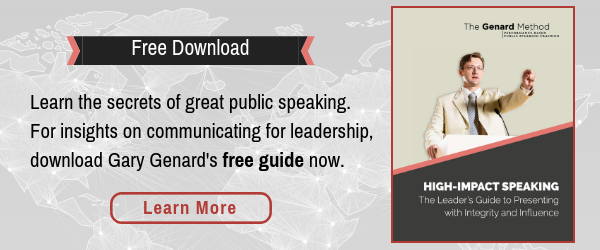Looking for a smart way to get your public speaking audience to take some action? Here's how to do it reliably and successfully!
It's an age-old and central question that nonetheless often gets ignored: "What's the action that I want my audience to take as a result of my presentation?"
We're so apt to get wrapped up in our content like a dance with an octopus that we sometimes never get around to asking that key question. Understand by "action" I don't necessarily mean getting people to sign a petition, buy your product, or immediately run out into the street to storm the state house. Action can mean changing people's thoughts or emotions, broadening their outlook, gaining buy-in to your ideas, etc.
You need to start persuading right from the start! Learn how in my Free Guide, "How to Start a Speech: 12 Foolproof Ways to Grab Your Audience."
Let's say you're on the right wavelength and you've thought carefully about the action you want listeners to take after listening to your talk. You're quite clear about it in your own mind. That's because you understand that a presentation with a clear purpose and desired result will have a much better chance at succeeding than one that's basically a data dump.
And to make this happen, you cleverly design a strong call-to-action at the end of the talk. That will do it, you realize! Well, no. All that will accomplish is that you'll be holding onto the barn door as the horse that just ran past it gallops off into the distance.
Learn more about how successful presentations are made. Get my Free Guide for engaging and moving audiences, "Six Rules of Effective Public Speaking."
Start Your Persuasion Early
By all means, include a compelling call-to-action in your conclusion. But you must start the process much earlier if you want your listeners to be persuaded enough to take the action.
Unfortunately, we don't often think of public speaking as a strategic activity, but it certainly is. That means you have to plan your strategy ahead of time. In this case, grooming your audience to be ready to act the moment you actually ask them to.
Here's more on strategies for moving audiences. Discover techniques for making what you say unforgettable! Get my Free cheat sheet, "5 Ways to Captivate an Audience."
Imagine you're the audience member, and you're listening to a presentation. The presenter brings in data from every source imaginable; and if you can still see over that enormous data hump, they show slides that transform the data into extreme visual complexity. (Sounds like fun so far, doesn't it?) They also may make a recommendation or two somewhere in there. Then comes more sources, more numbers, and a cartoon to make everything sufficiently jolly.
AND THEN, in the conclusion, they basically say, "As a result of all this irrefutable information, you should DO THIS." To which you are entitled to reply: "Why should I?" If, on the other hand (because of paying attention to strategy), this speaker had built the elements of persuasion, brick by brick, from the start of the presentation, they will have taken their audience by this stage along an important highway. It's on the signpost up ahead: What's In It For Me Road.
Want to know more about persuading listeners? Build credibility as you gain trust! Find out how in my Free ebook, 12 Easy Ways to Achieve Presence and Charisma.
Brick by Brick: How best can you build your argument? In two ways: 1) Shape everything you say in terms of its relevance to listeners, while getting them to understand the connection, and 2) Use evidence to back up everything you say (the types you select are up to you, based on your audience and topic). Otherwise it's just your opinion, and why should anyone be convinced by that?
Don't Neglect an Essential Tool: Your Slides
You also need to revolutionize your slides. Well, maybe not that radical an action. How about, revolt a little?
Use PowerPoint in ways that actually engage and persuade! Get my essential cheat sheet, "5 Rules for Succeeding with PowerPoint."
Among the crimes against humanity that PowerPoint and other slide software have perpetuated, is the dead space that occupies the top of slides. You know, the space where you see these words: "Introduction," "Agenda," "Thanks," and "Any Questions?" (Don't worry, I won't tell anybody about your secret!)
The first two of these headlines should be retitled, HARD WORK AHEAD. And the other two are really saying, I HAVE NO IDEA HOW TO END THIS PRESENTATION. So, a general rule: ubiquitous headlines that everyone ignores and don't say anything useful are bad. But worse in my mind is the fact that these presenters are ignoring great opportunities to get their points across.
Slide headlines should say something about what's on the slide, but in a more interesting way than "Agenda". The headline actually offers the chance to tap into the audience's experience at this point and help the conversation along. For instance, instead of a headline that announces "Principal Steps in the XXX Process," a slide's heading might say, "We're on the right road. What's the next exit look like?" Notice the lower case, the conversational tone, and the overall human vs. institutional feel.
With any slide deck, the strategy should always be: make the slides follow the story, and bring in a slide at just the moment when it has the most visual impact. Creative headlines allow you to tell that story in a much more interesting way. And once again, they're instrumental in leading the audience toward the action that should occur once the presentation is complete.
You should follow me on Twitter here.
Gary Genard is an actor, author, and expert in public speaking training and overcoming speaking fear. His company, Boston-based The Genard Method offers live 1:1 Zoom executive coaching and corporate group training worldwide. In 2021 for the eighth consecutive year, Gary has been ranked by Global Gurus as One of the World’s Top 30 Communication Professionals. He is the author of the Amazon Best-Seller How to Give a Speech. His second book, Fearless Speaking, was named in 2019 as "One of the 100 Best Confidence Books of All Time." His latest book is The Online Meetings Handbook, now available at The Genard Method and at Amazon. To know more about TGM's services, Contact Gary here.
w






